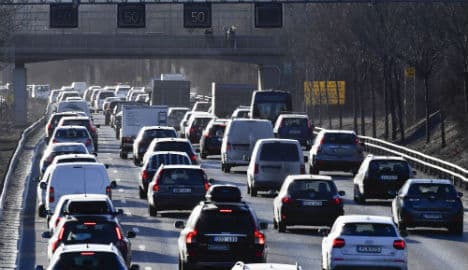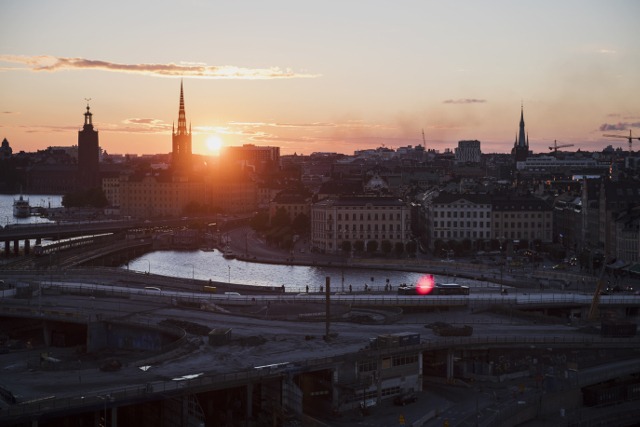Stockholm air quality 'best in 50 years': report

The air quality in Stockholm was better in 2017 than at any time since the 1960s, thanks to less polluting modern cars, a congestion charge, and unusually windy weather.
"You can say it’s the best air quality for 50 years, and that's across all measurements," Gunnar Söderholm, Director of the City of Stockholm’s Environmental and Health Administration, told The Local.
"If you take PM10 [soot particles], it was the lowest rate that we’ve seen since we started measurements in the 1980s. Nitrogen Dioxide (NO2) levels were the lowest in modern times."
MORE ON POLLUTION IN SWEDEN'S CAPITAL:
-
Stockholm one of world's least polluted capitals, WHO says
-
Stockholm registers air pollution 'as bad as Beijing'

According to the report, Luften i Stockholm 2017 (Air in Stockholm 2017), the city last year met EU requirements for NO2 emissions for the first time since 2011.
It even came close to meeting more stringent Swedish requirements, with all measuring stations except one — Hornsgatan on Södermalm — meeting the mandated levels. Even at Hornsgatan, the excess over allowed Swedish levels was down by 50 percent from 2016.
Söderholm said that in the long term, the improvement was due to the expansion of district heating networks in the city, less polluting modern vehicles, and the Stockholm congestion charge levied since August 2007.
But he admitted that the city had also been helped in 2017 by good weather.
"In 2017, it was more windy, and there was a milder winter than average, and that's a part of the reason," he said.
Söderholm conceded to the Dagens Nyheter newspaper that the figures could weaken the case for bringing in new low emissions zones in the city, which could help keep up the rate of improvement.
According to the report, produced by SLB-analys, NO2 levels at the problem spot in Hornsgatan fell from from 42.9 μg/m3 to 35.2 μg/m3, below the EU norm of 40 μg/m3.
Soot particle levels were down from 1.6 μg/m3 to 0.9 μg/m3 at Hornsgatan and 0.5 μg/m3 to 0,3 μg/m3 at Torkel Knutssonsgatan.
Carbon monoxide levels were more or less on a level with 2016, apart from on Sveagatan near the city centre, where there was a slight rise in the average level due to older cars and caravans travelling on the road during August.
Levels of Sulphur Dioxide (SO2) were 0.4 μg/m3 at Torkel Knutssonsgatan, well down on the five-year running average of 0.7 μg/m3.
Comments
See Also
"You can say it’s the best air quality for 50 years, and that's across all measurements," Gunnar Söderholm, Director of the City of Stockholm’s Environmental and Health Administration, told The Local.
"If you take PM10 [soot particles], it was the lowest rate that we’ve seen since we started measurements in the 1980s. Nitrogen Dioxide (NO2) levels were the lowest in modern times."
MORE ON POLLUTION IN SWEDEN'S CAPITAL:
- Stockholm one of world's least polluted capitals, WHO says
- Stockholm registers air pollution 'as bad as Beijing'

According to the report, Luften i Stockholm 2017 (Air in Stockholm 2017), the city last year met EU requirements for NO2 emissions for the first time since 2011.
It even came close to meeting more stringent Swedish requirements, with all measuring stations except one — Hornsgatan on Södermalm — meeting the mandated levels. Even at Hornsgatan, the excess over allowed Swedish levels was down by 50 percent from 2016.
Söderholm said that in the long term, the improvement was due to the expansion of district heating networks in the city, less polluting modern vehicles, and the Stockholm congestion charge levied since August 2007.
But he admitted that the city had also been helped in 2017 by good weather.
"In 2017, it was more windy, and there was a milder winter than average, and that's a part of the reason," he said.
Söderholm conceded to the Dagens Nyheter newspaper that the figures could weaken the case for bringing in new low emissions zones in the city, which could help keep up the rate of improvement.
According to the report, produced by SLB-analys, NO2 levels at the problem spot in Hornsgatan fell from from 42.9 μg/m3 to 35.2 μg/m3, below the EU norm of 40 μg/m3.
Soot particle levels were down from 1.6 μg/m3 to 0.9 μg/m3 at Hornsgatan and 0.5 μg/m3 to 0,3 μg/m3 at Torkel Knutssonsgatan.
Carbon monoxide levels were more or less on a level with 2016, apart from on Sveagatan near the city centre, where there was a slight rise in the average level due to older cars and caravans travelling on the road during August.
Levels of Sulphur Dioxide (SO2) were 0.4 μg/m3 at Torkel Knutssonsgatan, well down on the five-year running average of 0.7 μg/m3.
Join the conversation in our comments section below. Share your own views and experience and if you have a question or suggestion for our journalists then email us at [email protected].
Please keep comments civil, constructive and on topic – and make sure to read our terms of use before getting involved.
Please log in here to leave a comment.